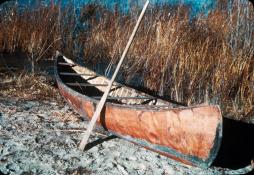
Before the fur trade, Aboriginal peoples used canoes to navigate the rivers, streams and lakes of northern Saskatchewan. Made entirely of local materials, these small birchbark canoes were light enough to portage the rapids and land connecting these rivers and lakes. With the arrival of the Europeans and the fur trade, these Aboriginal canoes were enlarged to deliver large payloads of trade goods and furs. At this time, the average fur trade canot du nord was eight metres long, weighed about 135 kg empty, and could support up to 2,000 kg of weight including a crew of between four and six voyageurs. Even with the introduction of heavy wood rowboats known as York boats in the 19th century, the fur trade version of the birchbark canoe continued to ply Saskatchewan's smaller streams and lakes. By the 20th century the fur trade had waned in importance, and the introduction of the motorboat increasingly replaced the working canoe. After World War II, however, recreational canoes that were larger than the early Aboriginal canoes but smaller than fur trade canoes became more common. They were first made out of different types of wood, but aluminum, plastic and more space-age materials have since been used to construct these canoes.
Greg Marchildon